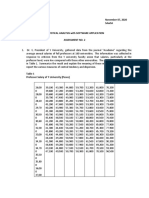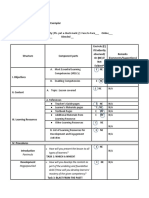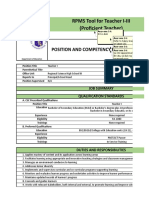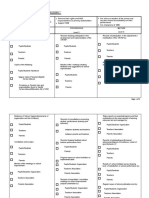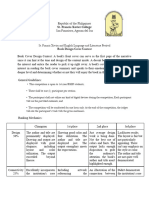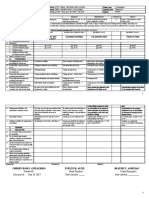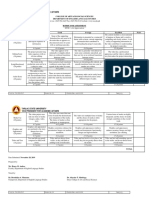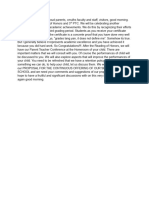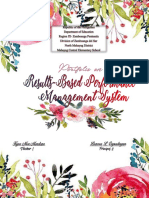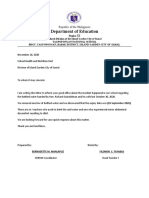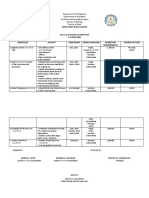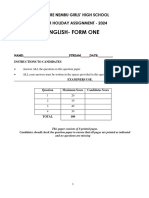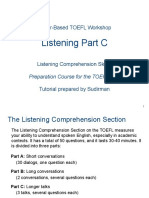100%(1)100% found this document useful (1 vote)
379 viewsAccountability and Continuous Improvement
Accountability and Continuous Improvement
Uploaded by
Lex Jethro ValdopenasThe document summarizes key aspects of an accountability system collaboratively developed by community stakeholders to monitor education performance. It defines roles and responsibilities, uses a performance system to address gaps, and ensures feedback mechanisms. The accountability criteria and tools are developed inclusively to regularly and participatively assess progress, using results to provide assistance, recognition, and plan adjustments.
Copyright:
© All Rights Reserved
Available Formats
Download as PPTX, PDF, TXT or read online from Scribd
Accountability and Continuous Improvement
Accountability and Continuous Improvement
Uploaded by
Lex Jethro Valdopenas100%(1)100% found this document useful (1 vote)
379 views8 pagesThe document summarizes key aspects of an accountability system collaboratively developed by community stakeholders to monitor education performance. It defines roles and responsibilities, uses a performance system to address gaps, and ensures feedback mechanisms. The accountability criteria and tools are developed inclusively to regularly and participatively assess progress, using results to provide assistance, recognition, and plan adjustments.
Original Description:
Summary of the Accountability and Continuous Improvement in Education
Copyright
© © All Rights Reserved
Available Formats
PPTX, PDF, TXT or read online from Scribd
Share this document
Did you find this document useful?
Is this content inappropriate?
The document summarizes key aspects of an accountability system collaboratively developed by community stakeholders to monitor education performance. It defines roles and responsibilities, uses a performance system to address gaps, and ensures feedback mechanisms. The accountability criteria and tools are developed inclusively to regularly and participatively assess progress, using results to provide assistance, recognition, and plan adjustments.
Copyright:
© All Rights Reserved
Available Formats
Download as PPTX, PDF, TXT or read online from Scribd
Download as pptx, pdf, or txt
100%(1)100% found this document useful (1 vote)
379 views8 pagesAccountability and Continuous Improvement
Accountability and Continuous Improvement
Uploaded by
Lex Jethro ValdopenasThe document summarizes key aspects of an accountability system collaboratively developed by community stakeholders to monitor education performance. It defines roles and responsibilities, uses a performance system to address gaps, and ensures feedback mechanisms. The accountability criteria and tools are developed inclusively to regularly and participatively assess progress, using results to provide assistance, recognition, and plan adjustments.
Copyright:
© All Rights Reserved
Available Formats
Download as PPTX, PDF, TXT or read online from Scribd
Download as pptx, pdf, or txt
You are on page 1of 8
A clear, transparent, inclusive, and
responsive accountability system is in place,
collaboratively developed by community
stakeholders, which monitors expected and
actual performance, continually addresses the
gaps, and ensures a venue for feedback and
redress.
1. Roles and responsibilities of accountable person/s
and collective body/ies are clearly defined and
agreed upon by community stakeholders.
The stakeholders are engaged in clarifying and defining their
specific roles and responsibilities.
There is an active party that initiates clarification of the roles
and responsibilities in education delivery.
Shared and participatory processes of determining roles,
responsibilities, and accountabilities of stakeholders in
managing and supporting education
2. Achievement of goals is recognized based on a
collaboratively developed performance
accountability system; gaps are addressed through
appropriate action.
Performance accountability is practiced at the school level.
A community-level accountability system is evolving from the
schooled initiatives.
A community-accepted performance accountability,
recognition and incentive system is being practiced.
3. The accountability system that is owned by the
community is continuously enhanced to ensure that
management structures and mechanisms are
responsive to the emerging learning needs and
demands of the community.
Community stakeholders are invited to participate in
setting up an accountability system for school-based
management processes, structures and mechanisms.
Community stakeholders contribute to the development of
an accountability system covers both school-based and
community-wide management of education.
A community- accepted accountability system effects
continuous improvement in the management of learning.
4. Accountability assessment criteria and tools, feedback
mechanisms, and information collection and validation
techniques and processes are inclusive and
collaboratively developed and agreed upon.
(PROCESS)
The school, with the participation of stakeholders,
articulates an accountability assessment framework with
basic components, including implementation guidelines.
Stakeholders are engaged in the development and operation of
an appropriate accountability assessment system.
Stakeholders continuously and collaboratively review and
enhance accountability systems’ processes, mechanisms and
tools.
5. Participatory assessment of performance is done
regularly with the community. Assessment results
and lessons learned serve as basis for feedback,
technical assistance, recognition and plan
adjustment.
School initiated periodic performance assessments which
involve participation of stakeholders.
Collaborative conduct of performance assessment informs
planning, plan adjustments and requirements for technical
assistance.
School – community-developed performance assessment
is practiced and is the basis for improving monitoring and
evaluation systems, provision of technical assistance,
recognition and refinement of plans.
Thank You!
You might also like
- Topic 6 IB TB Questions and AnswersDocument33 pagesTopic 6 IB TB Questions and Answersgeorgia92% (12)
- English 9 Learning Activity Sheet Quarter 4 MELC 1 NAME: - DATE: - GRADE LEVEL: - SECTIONDocument3 pagesEnglish 9 Learning Activity Sheet Quarter 4 MELC 1 NAME: - DATE: - GRADE LEVEL: - SECTIONChristina FactorNo ratings yet
- Manalo, Cristian James P. November 07, 2020 BSA 2-11 SawsaDocument5 pagesManalo, Cristian James P. November 07, 2020 BSA 2-11 SawsaCristian James ManaloNo ratings yet
- LP 7e's #1 - G10Document2 pagesLP 7e's #1 - G10rosemie olimNo ratings yet
- Checklist For IDEA Lesson Exemplar ARGELDOCTORADocument2 pagesChecklist For IDEA Lesson Exemplar ARGELDOCTORADoctora Arj100% (1)
- Lac Session ShsDocument2 pagesLac Session ShsLubeth CabatuNo ratings yet
- Regional Memorandum 090 S. 2020 (Module)Document3 pagesRegional Memorandum 090 S. 2020 (Module)Agui S. T. Pad100% (1)
- Brigada EskwelaDocument133 pagesBrigada EskwelaMay Anne AlmarioNo ratings yet
- RPMS Tool For Teacher I-III (Proficient Teacher) : Position and Competency ProfileDocument31 pagesRPMS Tool For Teacher I-III (Proficient Teacher) : Position and Competency ProfileLawrence CruzNo ratings yet
- Enrollment Instructions To NEAP TEACH ON LearnersDocument6 pagesEnrollment Instructions To NEAP TEACH ON LearnerspedroNo ratings yet
- Poonbato Integrated School: School Memorandum No. 04, S. 2020Document2 pagesPoonbato Integrated School: School Memorandum No. 04, S. 2020Bryan JesterNo ratings yet
- Assessment Tool Dimension 2 INTERNAL STAKEHOLDERS - 000Document5 pagesAssessment Tool Dimension 2 INTERNAL STAKEHOLDERS - 000ryanNo ratings yet
- Cot - DLP Gal 10 1920 BDocument2 pagesCot - DLP Gal 10 1920 BTaritz Gagucas-MAdrid100% (1)
- Gad Integrated Lesson Plan 2Document16 pagesGad Integrated Lesson Plan 2Princess Lynn Aquino Padua100% (1)
- Correct and Appropriate Multimedia ResourcesDocument7 pagesCorrect and Appropriate Multimedia ResourcesKendra ScarletNo ratings yet
- Lesson Plan in English IV - 1Document1 pageLesson Plan in English IV - 1Jay Silvosa AyapNo ratings yet
- Weekly Accomplishment ReportDocument10 pagesWeekly Accomplishment ReportMa. Victoria LlameraNo ratings yet
- Smea Dashboard: Catarman National High School Senior High SchoolDocument22 pagesSmea Dashboard: Catarman National High School Senior High SchoolArthur Capawing100% (2)
- ENGLISH LEARNING MANAGEMENT MATRIX Grade 7-10Document18 pagesENGLISH LEARNING MANAGEMENT MATRIX Grade 7-10Antonette RamosNo ratings yet
- A Critique Paper On The Principals Approach Planning: The Influence of Gender and ExperiencesDocument3 pagesA Critique Paper On The Principals Approach Planning: The Influence of Gender and ExperiencesversmajardoNo ratings yet
- Sample Certificates EditableDocument2 pagesSample Certificates Editablemichelle100% (1)
- Balak RubricsDocument1 pageBalak RubricsJovie Ababon BellitaNo ratings yet
- Session Guide DLL ARTDocument6 pagesSession Guide DLL ARTjaymar padayaoNo ratings yet
- School Reading Remediation Program (SRRP) Monitoring Tool: Description As Stated Issues and Concerns Recommendation/sDocument10 pagesSchool Reading Remediation Program (SRRP) Monitoring Tool: Description As Stated Issues and Concerns Recommendation/sRhea M. VillartaNo ratings yet
- Chapter 1: Assessment of Student's Learning in The Philippine SettingDocument20 pagesChapter 1: Assessment of Student's Learning in The Philippine SettingHaezil MioleNo ratings yet
- National High School Table of Specification: Learning CompetencyDocument1 pageNational High School Table of Specification: Learning CompetencyKinray Bade100% (1)
- Book Cover Design Contest Guidelines and MechanicsDocument2 pagesBook Cover Design Contest Guidelines and MechanicsLeah Rose MenozaNo ratings yet
- DLL in English 10 June 19-23, 2017Document2 pagesDLL in English 10 June 19-23, 2017Don Angelo De GuzmanNo ratings yet
- Final Rubric For Movie TrailerDocument2 pagesFinal Rubric For Movie TrailerHenry Mateo AndresNo ratings yet
- Department of Education: Republic of The PhilippinesDocument2 pagesDepartment of Education: Republic of The PhilippinesRhea Bercasio-Garcia100% (1)
- The Effects of Radio-Based Instruction To Caniangan National High School Learners and TeachersDocument9 pagesThe Effects of Radio-Based Instruction To Caniangan National High School Learners and TeachersMhiss JB100% (1)
- Survey Form in FilipinoDocument4 pagesSurvey Form in FilipinoBhem Fernandez Romero100% (1)
- Video BasedDocument36 pagesVideo BasedRhodz Rhodulf CapangpanganNo ratings yet
- English7 - Q2 - Mod5 - Summarizing A Text - v5Document33 pagesEnglish7 - Q2 - Mod5 - Summarizing A Text - v5Trisha Jane Blantucas100% (1)
- Opening Remarks For Reading of HonorsDocument1 pageOpening Remarks For Reading of HonorsJoemar CapuyanNo ratings yet
- A Detailed Lesson Plan For K-12 Curriculum English Grade 7 Analogy To Show Relationships of WordsDocument6 pagesA Detailed Lesson Plan For K-12 Curriculum English Grade 7 Analogy To Show Relationships of Wordshoney jean gomezNo ratings yet
- Seal of Exemplary Leadership & School Governance (Elsg)Document17 pagesSeal of Exemplary Leadership & School Governance (Elsg)GianJyrellAlbertoCorlet100% (1)
- School Form 2 (SF2) Daily Attendance Report of Learners: N o V e M B e RDocument3 pagesSchool Form 2 (SF2) Daily Attendance Report of Learners: N o V e M B e RPercy Brenda ModeloNo ratings yet
- National Reading MonthDocument3 pagesNational Reading MonthVILLA 2 ANACITA LOCIONNo ratings yet
- Grade9 ShowMeYourModalsDocument11 pagesGrade9 ShowMeYourModalsRinalyn MendezNo ratings yet
- Filipino PoetryDocument3 pagesFilipino PoetryKRISTEL JANE ALBISO100% (1)
- Idlar For July 2021Document2 pagesIdlar For July 2021Cherry Mae Morales BandijaNo ratings yet
- Undersecretary For Curriculum and Instruction: LegendDocument5 pagesUndersecretary For Curriculum and Instruction: LegendNeil Joshua AlmarioNo ratings yet
- Sample Session Learning EpisodeDocument1 pageSample Session Learning EpisodeJANETH GUTIERREZ100% (1)
- RPMS KyraDocument39 pagesRPMS KyraJoan PurificacionNo ratings yet
- English Lesson Plan Charater and ThemeDocument8 pagesEnglish Lesson Plan Charater and ThemeJasmin CaballeroNo ratings yet
- Recognizing Propaganda Technique DLLDocument5 pagesRecognizing Propaganda Technique DLLRosalie Andres CalmaNo ratings yet
- SBM 2016 ApatDocument69 pagesSBM 2016 ApatGreg Terrones MuecoNo ratings yet
- Certificate of AppreciationFINALDocument10 pagesCertificate of AppreciationFINALKelvin Jay Cabreros LapadaNo ratings yet
- End-Of-School Year Rites 2020-2021 - Message of RD Art BayocotDocument1 pageEnd-Of-School Year Rites 2020-2021 - Message of RD Art BayocotKRIS EVE REQUINA100% (4)
- IPPDDocument2 pagesIPPDJL Indiano100% (1)
- Department of Education: Republic of The PhilippinesDocument1 pageDepartment of Education: Republic of The Philippinesᜇᜓᜇᜓᜅ᜔ ᜄᜌᜓᜐ100% (1)
- Renovation of Classroom Windows of The U-Building in Technological University of The Philippines Cavite in The YEAR 2020Document4 pagesRenovation of Classroom Windows of The U-Building in Technological University of The Philippines Cavite in The YEAR 2020John BelenNo ratings yet
- W A T C H-Action-PlanDocument2 pagesW A T C H-Action-PlanMa jell Sotomayor100% (1)
- PPST - RP - Module 6Document38 pagesPPST - RP - Module 6Leodejoy Ruiz TulangNo ratings yet
- Monitoring Tool For The Opening of Classes 2023 2024 2Document7 pagesMonitoring Tool For The Opening of Classes 2023 2024 2MARK ANTHONY PALATTAONo ratings yet
- Certificate of Recognition Career GuidanceDocument1 pageCertificate of Recognition Career GuidanceRose Ann CoNo ratings yet
- Reorientation Thrust and Innovation in Teacher EducationDocument4 pagesReorientation Thrust and Innovation in Teacher EducationRochelle AnneNo ratings yet
- 1 DepED SHS Voucher ProgramDocument14 pages1 DepED SHS Voucher ProgramaveheeNo ratings yet
- FORM 3: LAC Session Report: Region: Iii Lac Session No.: 6 Venue/Platform of SessionDocument3 pagesFORM 3: LAC Session Report: Region: Iii Lac Session No.: 6 Venue/Platform of SessionMon Eric Lomeda100% (1)
- SBM Best PracticesDocument12 pagesSBM Best PracticesAMELOU AUSTRIANo ratings yet
- MYEGDocument31 pagesMYEGCalvin TehNo ratings yet
- The Shia Identity Persecution Horizons Victims of Terrorism and Extremism 1st Edition Riyadh Al-Hakim download pdfDocument45 pagesThe Shia Identity Persecution Horizons Victims of Terrorism and Extremism 1st Edition Riyadh Al-Hakim download pdfmanyexignara100% (1)
- 35-Article Text-158-1-10-20220424Document8 pages35-Article Text-158-1-10-20220424kelompok 4 Ekonomi lingkunganNo ratings yet
- Form 1 English Assignment April 2024 Assignments - Form 1 - EnglishDocument8 pagesForm 1 English Assignment April 2024 Assignments - Form 1 - Englishalexandernyamari012No ratings yet
- DLL in TLE CROP PRODUCTION G8-7.doc Version 1Document143 pagesDLL in TLE CROP PRODUCTION G8-7.doc Version 1Maira M. SaliNo ratings yet
- Listening Skill Part CDocument13 pagesListening Skill Part CNaufal Fadli AmzarNo ratings yet
- Quantitative Aptitude AssignmentDocument3 pagesQuantitative Aptitude AssignmentnikhilNo ratings yet
- CH 1Document21 pagesCH 1Naina GargNo ratings yet
- 2.875 Eue 6.50 L80 TubingDocument1 page2.875 Eue 6.50 L80 TubingALEX MAKANGANo ratings yet
- LacosteDocument21 pagesLacosteSunny SharmaNo ratings yet
- Cerebra Integrated Technologies LimitedDocument78 pagesCerebra Integrated Technologies LimitedPrashanth PBNo ratings yet
- Research TitleDocument25 pagesResearch TitleMonica MinaNo ratings yet
- The Princess and The Packet of Frozen Peas Original DraftDocument5 pagesThe Princess and The Packet of Frozen Peas Original DraftTony Wilson100% (1)
- Mutant - SabroToneDocument1 pageMutant - SabroToneMajk StoneNo ratings yet
- PHYSCIS PROJECT On Moving Coil GalvanomeDocument18 pagesPHYSCIS PROJECT On Moving Coil GalvanomeMaths GuptaNo ratings yet
- Pictorial Key To TarotDocument381 pagesPictorial Key To TarotDishani SarkarNo ratings yet
- Ucsp Hand-Outs Module 1Document3 pagesUcsp Hand-Outs Module 1Joa PingalNo ratings yet
- Shard of Spring - Manual - C64 PDFDocument14 pagesShard of Spring - Manual - C64 PDFMark BallingerNo ratings yet
- 25.1. Solis v. BarrosoDocument6 pages25.1. Solis v. BarrosorafNo ratings yet
- Die_with_Zero_31052024_052149_PMDocument3 pagesDie_with_Zero_31052024_052149_PMyayicat943No ratings yet
- Collective ResponsibilityDocument34 pagesCollective ResponsibilityalbertolecarosNo ratings yet
- Business Environment Report OnDocument6 pagesBusiness Environment Report OnzombeeeeNo ratings yet
- Egyptian Response Spectrum: According To The ECP 201-2012Document16 pagesEgyptian Response Spectrum: According To The ECP 201-2012pqnamwNo ratings yet
- ĐỀ THI MÔN TIẾNG ANHDocument10 pagesĐỀ THI MÔN TIẾNG ANHKhánh Linh HàNo ratings yet
- Shell Mex House Pearsons PLC History British Intelligence and OilDocument8 pagesShell Mex House Pearsons PLC History British Intelligence and OilJohn Adam St Gang: Crown ControlNo ratings yet
- GST 105 History and Philosophy of ScienceDocument230 pagesGST 105 History and Philosophy of ScienceChukwunweike EmmanuelNo ratings yet
- Blasphemy PDFDocument2 pagesBlasphemy PDFAnn!3No ratings yet
- JAVA 8 FeaturesDocument34 pagesJAVA 8 FeaturesGaurav PathakNo ratings yet


